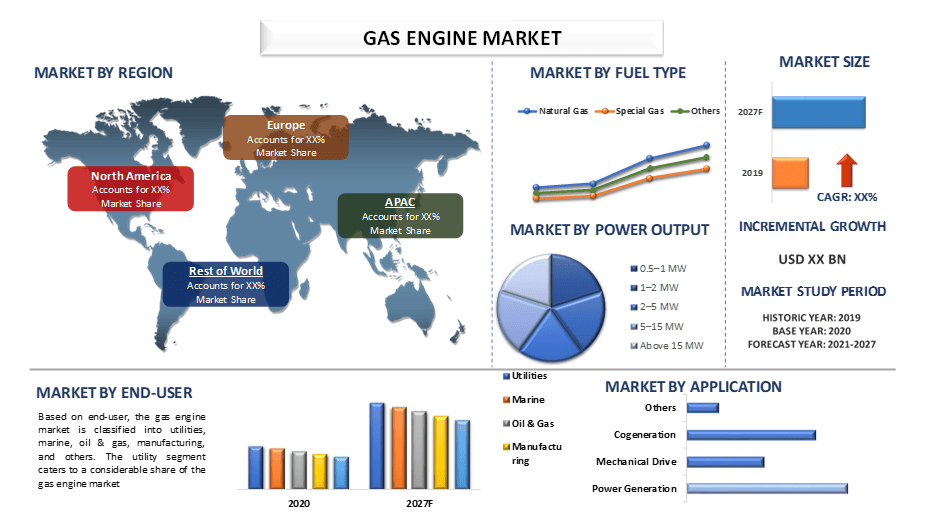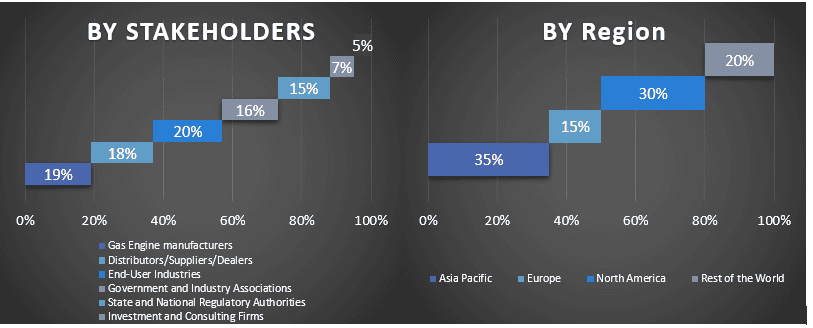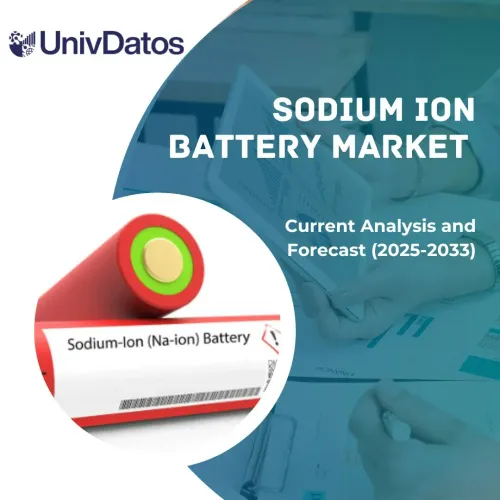
预计全球燃气发动机市场在预测期(2021-2027)内的复合年增长率将超过4.5%。燃气发动机市场正在蓬勃发展,预计在预测期内将实现显著增长。支持其增长的因素包括对高效、低碳发动机的需求增加,以及技术进步。各公司正在投资并采用先进的小型燃气发动机,这些发动机维护成本低,产品成本降低,从而满足市场需求。
此外,来自不同国家的排放监测和监管机构正在对柴油发动机和发电机的使用施加更严格的法规。为了满足这些监管标准,各行业正在部署燃气发动机和发电机进行发电,预计这将扩大燃气发动机的市场规模。
燃气发动机,终端用户,2020年

康明斯公司、三菱重工业株式会社、罗尔斯·罗伊斯公司、大众汽车股份公司、瓦锡兰、科勒公司、雅马哈发动机有限公司、现代重工有限公司、中国玉柴国际有限公司、西门子。这些参与者已进行多项并购和合作,旨在为客户提供高科技和创新产品/技术。
报告中呈现的见解
“在燃料类型中,天然气细分市场占据主要份额”
根据燃料类型,燃气发动机市场被划分为天然气、特殊气体及其他。天然气细分市场在燃气发动机市场中占据了巨大的市场份额,预计将在预测期内成为增长最快的细分市场。这主要是由于天然气是最清洁的化石燃料,与其他燃料相比,产生的碳排放更少。因此,它在燃气发动机市场中的市场需求不断增加。
“在功率输出中,1-2兆瓦细分市场占据主要份额”
根据功率输出,燃气发动机市场被划分为0.5–1兆瓦、1–2兆瓦、2–5兆瓦、5–15兆瓦及15兆瓦以上。1-2兆瓦细分市场在燃气发动机市场中占据了 значительный 的市场份额。由于这些发电机主要用于热电联产系统和发电。在热电联产中,发动机在发电的同时还提供空间供暖和水加热所需的能量,从而实现高达60%的节能。
“在终端用户中,公用事业细分市场占据主要份额”
根据终端用户,燃气发动机市场被划分为公用事业、海运、石油与天然气、制造业及其他。公用事业细分市场在燃气发动机市场中占据 considerable 的份额。公用事业产生的电力可以为当地设施供电或出口到当地电网。由于向燃气发电厂转移,以减少温室气体排放,从而遵守政府 imposed 的碳排放 regulations,正在扩大燃气发动机的市场规模。
“亚太地区在全球燃气发动机市场中占据 extensive 的市场份额”
为了更好地理解全球燃气发动机的市场动态。由于对电力的需求不断增长,以及许多国家不断关注采用清洁可靠的能源,预计亚太地区在预测期内的增长率将是最高的,这正在扩大燃气发动机的市场规模。
购买本报告的原因:
- 该研究包括了经过验证的由权威行业专家提供的市场规模和预测分析。
- 该报告简要介绍了整个行业的业绩。
- 该报告深入分析了主要的行业同业,主要关注关键的业务财务状况、产品组合、扩张战略和近期发展。
- 详细 examination 行业中 prevailing 的驱动因素、限制因素、主要趋势和机会。
- 该研究全面涵盖了不同细分市场。
- 行业深层次的 regional 层面分析。
定制选项:
全球燃气发动机市场可根据需求或任何其他细分市场进行进一步定制。除此之外,UMI 了解到您可能拥有自己的业务需求,因此请随时与我们联系以获取完全符合您要求的报告。
目录
分析历史市场,估算当前市场,并预测全球燃气发动机市场的未来市场,是创建和分析燃气发动机在全球主要地区应用情况的三个主要步骤。进行了详尽的 secondary research 以收集历史市场数据并估算当前市场规模。其次,为了验证这些见解,考虑了许多 findings 和 assumptions。此外,还对全球燃气发动机市场的 value chain 的行业专家进行了 exhaustive primary interviews。在通过 primary interviews 进行市场数据的假设和验证之后,我们采用了自上而下/自下而上的方法来预测完整的市场规模。此后,采用了市场细分和数据 triangulation 方法来估算和分析与行业相关的细分市场和子细分市场的市场规模。详细的方法如下:
历史市场规模分析
步骤1:深入研究 secondary sources:
进行了详细的 secondary study 以通过公司内部来源(例如)获取燃气发动机市场的历史市场规模年度报告和财务报表、业绩演示、新闻稿等以及包括外部来源期刊、新闻和文章、政府出版物、竞争对手出版物、行业报告、第三方数据库和其他可靠出版物。
步骤2:市场细分:
在获得燃气发动机市场的历史市场规模后,我们进行了详细的 secondary analysis,以收集主要地区的各个细分市场和子细分市场的历史市场见解和份额。主要细分市场包括报告中涵盖的燃料类型、功率输出、应用、终端用户和地区。进一步进行了国家层面的分析,以评估在该地区全面采用测试模型的情况。
步骤3:因素分析:
在获取不同细分市场和子细分市场的历史市场规模后,我们进行了详细的因素分析以估算燃气发动机市场的当前市场规模。此外,我们使用 dependent 和 independent variables(例如,对高效和低碳发动机的需求增加)进行了因素分析。考虑到全球燃气发动机市场 sector 的主要 partnerships、mergers 和 acquisitions、业务扩张和产品发布,对 demand 和 supply-side 的情景进行了 thorough 的分析。
当前市场规模估算和预测
当前市场规模估算:根据上述3个步骤的可操作见解,我们得出了当前的市场规模、全球燃气发动机市场的主要参与者以及各细分市场的市场份额。所有 required 的百分比份额拆分和市场细分均使用上述 secondary 方法确定,并通过 primary interviews 进行了验证。
估算与预测:对于市场估算和预测,权重被分配给不同的因素,包括驱动因素和趋势、限制因素以及利益相关者可用的机会。在分析了这些因素之后,应用了相关的预测技术,即自上而下/自下而上方法,以得出2027年全球主要市场不同细分市场和子细分市场的市场预测。用于估算市场规模的研究方法包括:
- 行业的市场规模,以价值(美元)和燃气发动机市场在主要市场上的采用率
- 市场细分和子细分的所有百分比份额、拆分和细分
- 全球燃气发动机市场中按所提供类别划分的主要参与者。此外,这些参与者为在快速增长的市场中竞争而采取的增长策略
市场规模和份额验证
一手研究:与包括主要地区的高级管理人员(CXO/VP、销售主管、市场营销主管、运营主管、区域主管、国家主管等)在内的主要意见领袖(KOL)进行了深入访谈。然后对一手研究结果进行总结,并进行统计分析以证明所述假设。将一手研究的输入与二手研究结果合并,从而将信息转化为可操作的见解。
不同地区一手参与者的拆分

市场工程
采用数据三角测量技术来完成整体市场估算,并得出全球燃气发动机市场每个细分市场和子细分市场的精确统计数据。在研究了燃料类型、功率输出、应用和最终用户等领域的各种参数和趋势后,将数据拆分为几个细分市场和子细分市场。
全球燃气发动机市场研究的主要目标
在研究中指出了全球燃气发动机市场的当前和未来市场趋势。投资者可以获得战略见解,以便根据研究中进行的定性和定量分析来决定投资。当前和未来的市场趋势决定了市场在区域层面的整体吸引力,为行业参与者提供了一个平台,以利用尚未开发的市场,从而获得先发优势。研究的其他定量目标包括:
- 按价值(美元)分析燃气发动机市场的当前和预测市场规模。此外,分析不同细分市场和子细分市场的当前和预测市场规模
- 研究中的细分市场包括燃料类型、功率输出、应用和最终用户领域。
- 定义和分析燃气发动机市场行业的监管框架。
- 分析涉及各种中间商的价值链,以及分析行业的客户和竞争对手行为。
- 分析主要地区的燃气发动机市场的当前和预测市场规模。
- 报告中研究的主要地区包括亚太地区、欧洲、北美和世界其他地区。
- 燃气发动机市场的公司概况以及市场参与者为在快速增长的市场中保持竞争优势而采取的增长策略
对行业的深度区域级分析
相关 报告
购买此商品的客户也购买了










